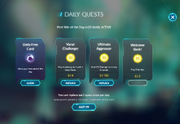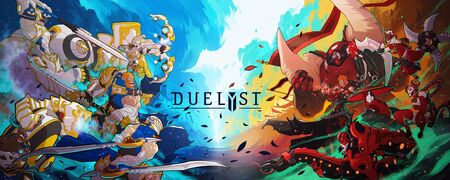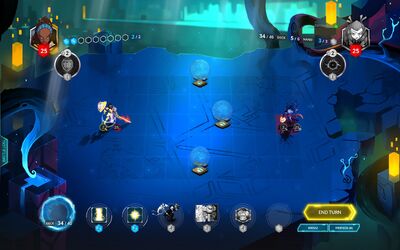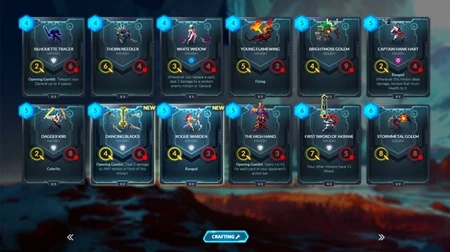Welcome to Duelyst! This page contains introductory information for new players as well as links to more detailed sources.
A short summary of the basics you can find here.
What Is Duelyst?[ | ]
Duelyst is an online collectible card game (CCG) with a board. Play is generally head-to-head between two humans, although some modes allow human players to compete against AI opponents.
Game Clients[ | ]
To play the game, you need to use one of the clients. You can download the standalone clients for Windows or Mac by follow this link and clicking “Play Now.” The steam client is available here. Depending on your computer's specification, you can also play in Google Chrome here. Mobile only works through some workarounds. Once you have downloaded the game, follow the prompts to create an account (or link an existing account) with Bandai Namco, the game’s publisher.
Basic Gameplay[ | ]
This is a very brief introduction to Duelyst's gameplay. For a more detailed description, see the gameplay page.
Duelyst is played between two players on a 9x5 board. At the beginning of the game, the board is occupied by the players' Generals. The goal of a game is to reduce the health of the other player's general to 0.
Each player starts with a deck of cards. Cards come in three varieties: minions; spells; and artifacts. Play takes place in turns. On their turn, a player may move their general and minions and attack adjacent enemies with their minions and general; summon new minions adjacent to their general, cast spells, and equip artifacts to their general. The player may also replace one of their cards. The player's actions are limited by the amount of mana they have and the number of cards they hold. There is also a time limit of 90 seconds per turn. The amount of mana available to the player increases every turn until it reaches its maximum. Players can also gain a one-time boost to their mana total by capturing one of the mana springs around the center of the board. Players draw an extra card from their deck at the end of their turn.
These general rules are subject to exceptions. Many minions have abilities that alter the normal rules of gameplay. Spells and artifacts can also alter the game's basic rules. Common abilities are indicated by "keywords" on cards. For example, a minion with the ranged keyword can attack any enemy, not just those adjacent to it. More unusual abilities are described in text on their cards.
Game Modes[ | ]
Duelyst currently has three head-to-head play modes: Ranked and Gauntlet, which are the Standard modes. Standard means that you can all cards except the ones which are rotated. The third mode is Unlimited in which you can play all cards that exist. Additional modes are practice mode, where you can play against the AI, and challenges, which are solo. Additionally, Duelyst has weekly Boss Battles, which are also against the AI.
Ranked is a ladder mode: you are placed in one of five divisions (from lowest to highest: bronze, silver, gold, diamond, and S-rank). You play Ranked mode with a deck of forty cards from your collection. The game's matchmaking system usually matches you against players from your division. Winning games grants you chevrons; losing takes them away. Earn enough chevrons and you advance to the next division. Once you move into a new division, you cannot drop out of it. Every season (every calendar month) the ranks are reset and players are given Ranked rewards depending on the rank they reached.
Gauntlet is a draft mode. When you enter Gauntlet, you draft a deck of 30 cards from a random selection of cards offered to you by the game. Your Gauntlet run continues until you have lost three games or won twelve games. The matchmaking engine attempts to match you against players with a similar number of wins. Players are given Gauntlet rewards depending on the number of games they won. You can only draft cards from the Standard set in this mode.
Building Your Collection[ | ]
As you progress in Duelyst, you can unlock more cards and can obtain other in-game items.
Here is a great F2P guide which tells you how to get the most out of Duelyst without any money.
In-game items:[ | ]
Cards and Orbs[ | ]
- You start with a collection of basic cards. These cannot be crafted or disenchanted, but you can gain more basic cards for each faction (including the secondary general) by leveling that faction up to level 11 (see Faction Progression).
- Other cards are gained from opening spirit orbs.
- Spirit orbs contain cards. They can be bought with gold or diamonds (obtained with real-world money) and are also offered as rewards for in-game events such as Gauntlet and Boss Battles.
- Each spirit orbs belongs to a set (such as the Core set or the Shim'zar set). It only contains cards from that set.
- Most cards can be crafted with spirit or disenchanted to gain spirit.
- Each card has a particular rarity level that affects how frequently it appears in orbs and how much spirit it is worth.
- There are also "prismatic" versions of every card.
- Prismatic cards cost more spirit to craft and yield more spirit when disenchanted.
- Prismatic cards have no special gameplay effect, but have a shiny appearance.
- Cards from the Rise of the Bloodbound and Ancient Bonds sets cannot be crafted or disenchanted.
- A few cards -- the Seven Sisters -- can only be obtained by having a certain number of other cards in your collection.
Crates and Cosmetics[ | ]
- Crates contain various cosmetic items: special Skins for generals and minions; Card Backs; Emotes; and Battle Maps. Depending on the crate type, it may also contain orbs or other items with gameplay value (for example the Boss Crate that can be obtained by defeating a Boss).
- Crates can be opened for free.
- A small number of skins have been given out as part of special promotions and are not available from crates.
- Most cosmetic items are craftable with spirit, but cannot be disenchanted.
Tips for building your collection[ | ]

- Before you play your first game against another human, enter another play's in-game name as a "referral code" in the Settings for a bonus 100 gold.
- Duelyst awards a free common card every day for logging in. This is available on the Quests screen.
- Duelyst awards 20 gold for your first win of the day (in Gauntlet or Ranked mode). This resets every 22 hours.
- Completing your daily quests earns you a good amount of gold.
- Completing the challenges will teach you about the game's mechanics and reward you with a decent amount of gold.
- There are a number of hidden achievements that grant extra rewards. Ones that people sometimes miss are playing a game against a friend and playing a game with every faction.
- Reaching gold rank by the end of the season (the calendar month) grants you a random legendary card. See Ranked Rewards.
- Generally, core orbs represent the best investment for new players because they drop higher-value cards at a better rate but check this guide for which orbs a new player should buy.
- If you are able to do well in Gauntlet (averaging 3 wins or more per run), it allows you to grow your collection quicker than ranked play. If you can frequently reach average 7+ wins per run, playing Gauntlet is a much more efficient way to grow your collection.
- If you want to spend real-world currency on your collection, first check an analysis of the most efficient way to spend it.
The Factions[ | ]
The game has six factions, each with its own identity. Here is a 'very' brief overview; you can learn more about each faction at its faction page. Although this section attempts to characterize each faction’s playstyle, deckbuilding is flexible enough that reasonably strong decks can be built for any faction with any playstyle. This section also ignores more specialized (and expensive) decks that new players are unlikely to encounter in their early games
What faction should I choose?[ | ]
Here is a quiz to help you decide on which faction to try first.
| Faction | Description |
|---|---|

|
Lyonar has a lot of high-health minions with good stats. It is often seen as a good faction for beginners to learn the game. The faction needs to get minions on the board and keep them there, because most of its spells rely on having minions on the board. |

|
Abyssian has excellent late-game minions and also has very strong support for developing and making use of a ‘swarm’ of small minions. Abyssian decks tend to be built either to survive to the late game and overwhelm their opponent with strong, high-cost minions, or to develop a swarm and take advantage of the faction’s swarm synergies. |
| Magmar has a lot of minions with an instant impact on the board. Magmar decks generally tend to be fairly aggressive, putting minions on the board and dealing damage to the enemy general at the same time. | |

|
Songhai has cheap, powerful spells, but fragile minions. Songhai decks often rely on spell combos to deal a lot of damage quickly. Songhai decks tend to be fairly aggressive. The faction relies a lot on mobility and has the best positioning spells in the game. |

|
Vanar has the game’s best removal and stalling spells, but generally mediocre minions. Vanar decks often rely on stalling to the late game while removing or delaying the opponent’s threats with spells. Vanar’s cheap removal spells also make it a strong faction for playing [arcanysts] — minions with particularly strong spell synergies. |

|
Vetruvian has access to obelysks — minions which do not attack or move themselves but generate a huge amount of value over time by summoning other minions. It also has a range of strong minions and utility spells — especially cards that ‘cycle’ by drawing another card. Vetruvian decks often rely on obelysks and cards that synergize with them to quickly develop a powerful board. |
Deckbuilding[ | ]
Deckbuilding is a rich and complicated part of Duelyst. See the wiki's deckbuilding links for more information and analysis.
You can view your decks by clicking on ‘collection’ on the game’s main screen. There is a tab for ‘starter decks’ — you have six; one for each faction. There is another tab for custom decks. A deck consists of 40 cards. One card is your general; the other 39 can be chosen from the cards in your collection. Each general can choose from their faction's cards and neutral minions.
You can have only one general in your deck; for any other card, you can have up to three copies, as long as you have those copies in your collection.
Tactics and Strategy[ | ]
Duelyst is an incredibly rich and deep game. See the wiki's new players' guides collection to learn about important basic knowledge for the game. The wiki's guide links offer even more resources to help you improve in your gameplay or find excellent decklists.
You also could ask an experienced player to help you out. For that look at the Mentors page.




